一、Sentinel簡介
Sentinel 以流量為切入點,從流量控制、熔斷降級、系統負載保護等多個維度保護服務的穩定性。
Sentinel 具有以下特征:
?豐富的應用場景:Sentinel 承接了阿里巴巴近 10 年的雙十一大促流量的核心場景,例如秒殺(即突發流量控制在系統容量可以承受的范圍)、消息削峰填谷、集群流量控制、實時熔斷下游不可用應用等。
?完備的實時監控:Sentinel 同時提供實時的監控功能。您可以在控制臺中看到接入應用的單臺機器秒級數據,甚至 500 臺以下規模的集群的匯總運行情況。
?廣泛的開源生態:Sentinel 提供開箱即用的與其它開源框架/庫的整合模塊,例如與 Spring Cloud、Apache Dubbo、gRPC、Quarkus 的整合。您只需要引入相應的依賴并進行簡單的配置即可快速地接入 Sentinel。同時 Sentinel 提供 Java/Go/C++ 等多語言的原生實現。
?完善的 SPI 擴展機制:Sentinel 提供簡單易用、完善的 SPI 擴展接口。您可以通過實現擴展接口來快速地定制邏輯。例如定制規則管理、適配動態數據源等。
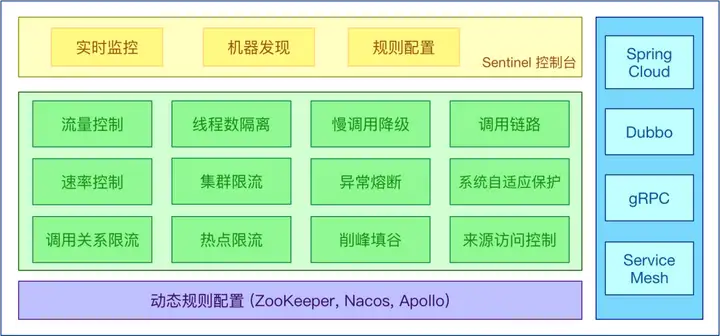
有關Sentinel的詳細介紹以及和Hystrix的區別可以自行網上檢索,推薦一篇文章:https://mp.weixin.qq.com/s/Q7Xv8cypQFrrOQhbd9BOXw
本次主要使用了Sentinel的降級、限流、系統負載保護功能
二、Sentinel關鍵技術源碼解析
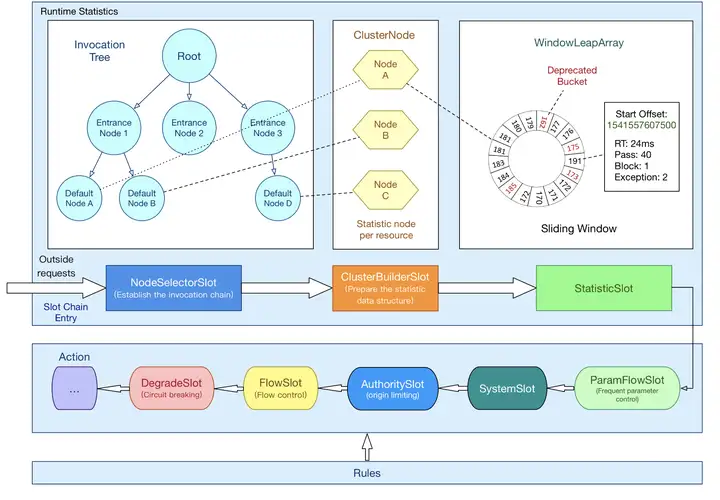
無論是限流、降級、負載等控制手段,大致流程如下:
?StatisticSlot 則用于記錄、統計不同維度的 runtime 指標監控信息
?責任鏈依次觸發后續 slot 的 entry 方法,如 SystemSlot、FlowSlot、DegradeSlot 等的規則校驗;
?當后續的 slot 通過,沒有拋出 BlockException 異常,說明該資源被成功調用,則增加執行線程數和通過的請求數等信息。
關于數據統計,主要會牽扯到 ArrayMetric、BucketLeapArray、MetricBucket、WindowWrap 等類。
項目結構
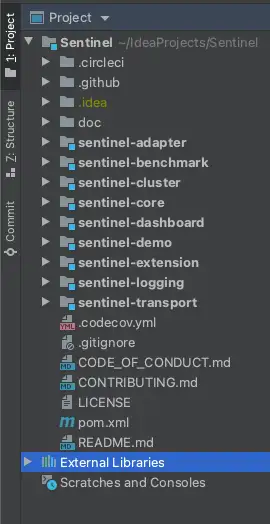
以下主要分析core包里的內容
2.1注解入口
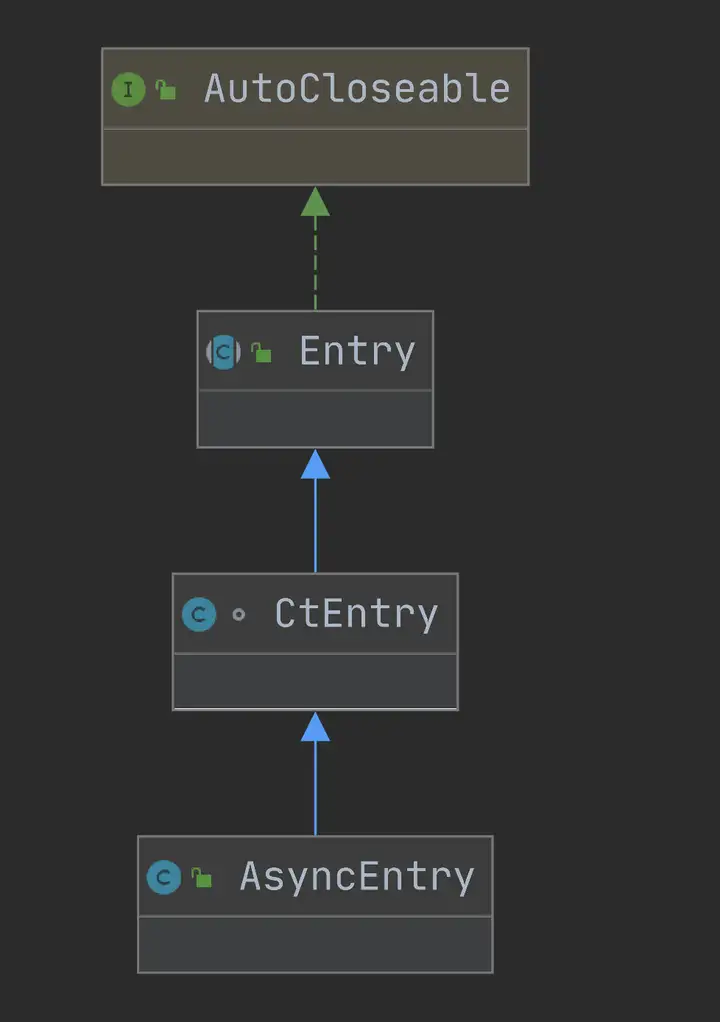
2.1.1 Entry、Context、Node
SphU門面類的方法出參都是Entry,Entry可以理解為每次進入資源的一個憑證,如果調用SphO.entry()或者SphU.entry()能獲取Entry對象,代表獲取了憑證,沒有被限流,否則拋出一個BlockException。
Entry中持有本次對資源調用的相關信息:
?createTime:創建該Entry的時間戳。
?curNode:Entry當前是在哪個節點。
?orginNode:Entry的調用源節點。
?resourceWrapper:Entry關聯的資源信息。
?
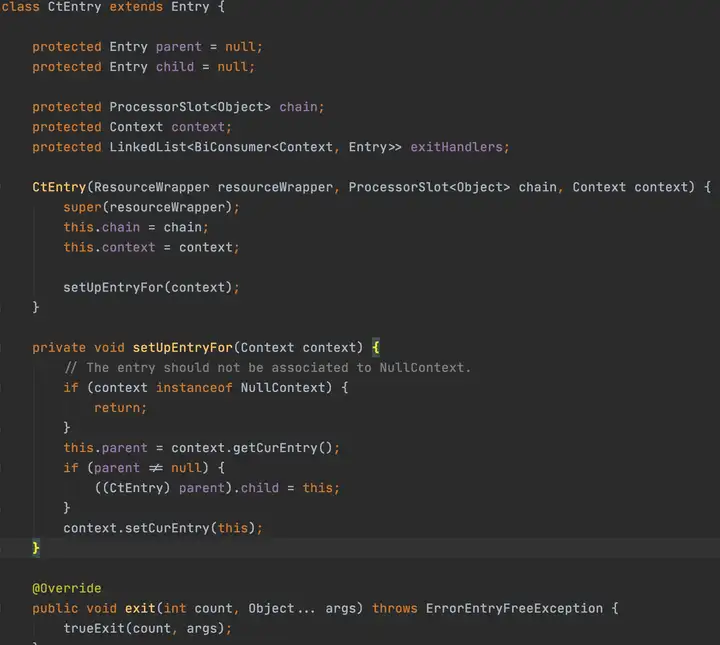
Entry是一個抽象類,CtEntry是Entry的實現,CtEntry持有Context和調用鏈的信息
Context的源碼注釋如下,
This class holds metadata of current invocation
Node的源碼注釋
Holds real-time statistics for resources
Node中保存了對資源的實時數據的統計,Sentinel中的限流或者降級等功能就是通過Node中的數據進行判斷的。Node是一個接口,里面定義了各種操作request、exception、rt、qps、thread的方法。

在細看Node實現時,不難發現LongAddr的使用,關于LongAddr和DoubleAddr都是java8 java.util.concurrent.atomic里的內容,感興趣的小伙伴可以再深入研究一下,這兩個是高并發下計數功能非常優秀的數據結構,實際應用場景里需要計數時可以考慮使用。
關于Node的介紹后續還會深入,此處大致先提一下這個概念。
2.2 初始化
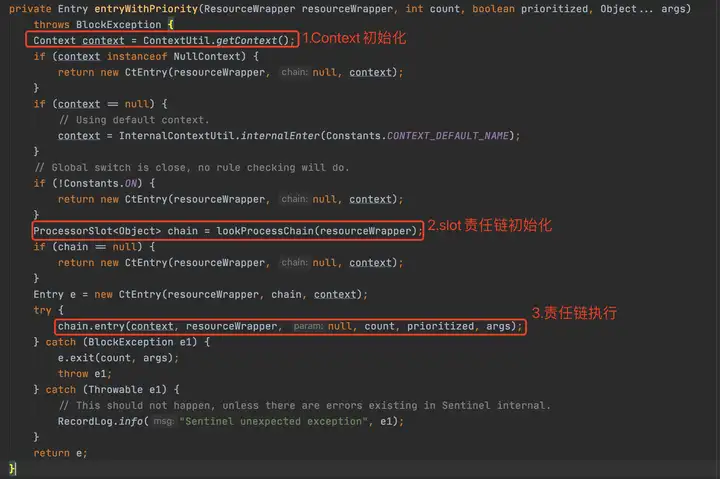
2.2.1 Context初始化
在初始化slot責任鏈部分前,還執行了context的初始化,里面涉及幾個重要概念,需要解釋一下:
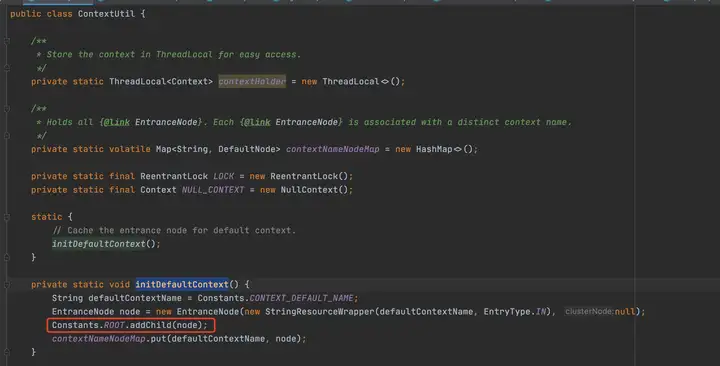
可以發現在Context初始化的過程中,會把EntranceNode加入到Root子節點中(實際Root本身是一個特殊的EntranceNode),并把EntranceNode放到contextNameNodeMap中。
之前簡單提到過Node,是用來統計數據用的,不同Node功能如下:
?Node:用于完成數據統計的接口
?StatisticNode:統計節點,是Node接口的實現類,用于完成數據統計
?EntranceNode:入口節點,一個Context會有一個入口節點,用于統計當前Context的總體流量數據
?DefaultNode:默認節點,用于統計一個資源在當前Context中的流量數據
?ClusterNode:集群節點,用于統計一個資源在所有Context中的總體流量數據
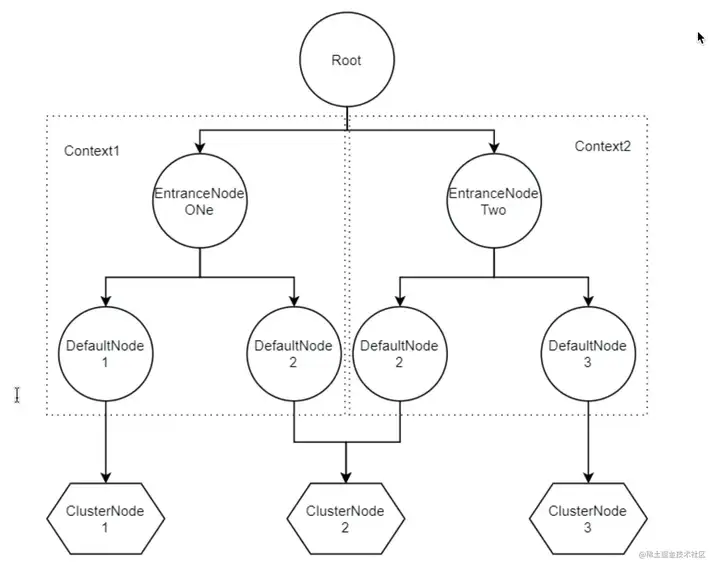
protected static Context trueEnter(String name, String origin) {
Context context = contextHolder.get();
if (context == null) {
Map localCacheNameMap = contextNameNodeMap;
DefaultNode node = localCacheNameMap.get(name);
if (node == null) {
if (localCacheNameMap.size() > Constants.MAX_CONTEXT_NAME_SIZE) {
setNullContext();
return NULL_CONTEXT;
} else {
LOCK.lock();
try {
node = contextNameNodeMap.get(name);
if (node == null) {
if (contextNameNodeMap.size() > Constants.MAX_CONTEXT_NAME_SIZE) {
setNullContext();
return NULL_CONTEXT;
} else {
node = new EntranceNode(new StringResourceWrapper(name, EntryType.IN), null);
// Add entrance node.
Constants.ROOT.addChild(node);
Map newMap = new HashMap(contextNameNodeMap.size() + 1);
newMap.putAll(contextNameNodeMap);
newMap.put(name, node);
contextNameNodeMap = newMap;
}
}
} finally {
LOCK.unlock();
}
}
}
context = new Context(node, name);
context.setOrigin(origin);
contextHolder.set(context);
}
return context;
}
2.2.2 通過SpiLoader默認初始化8個slot
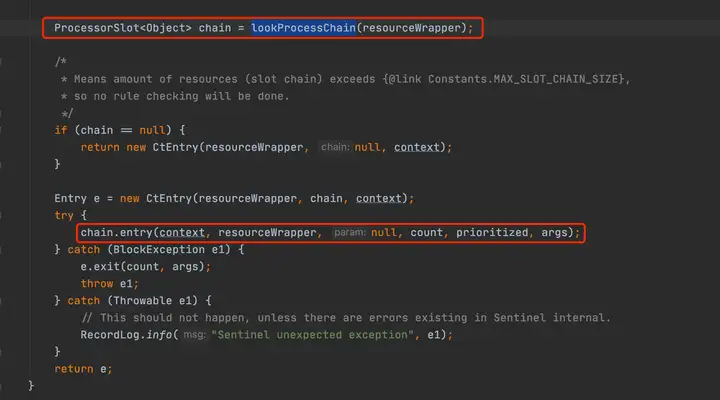
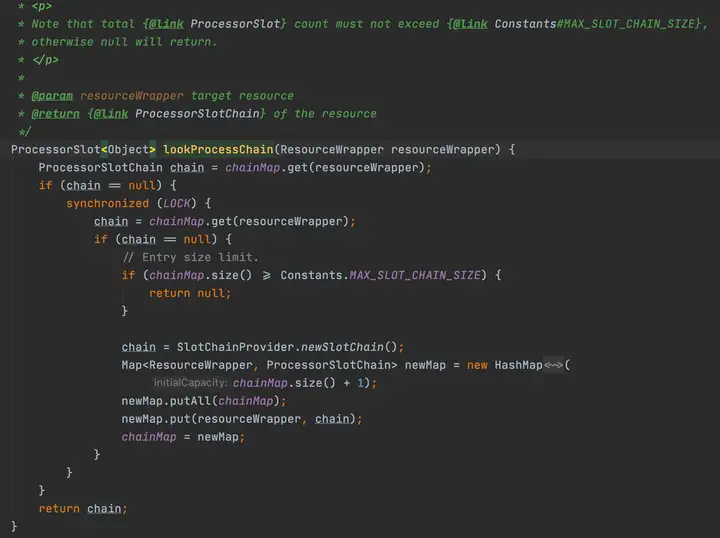
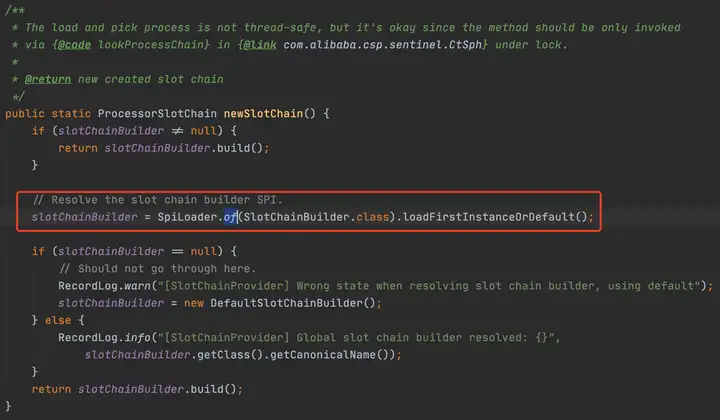


每個slot的主要職責如下:
?NodeSelectorSlot 負責收集資源的路徑,并將這些資源的調用路徑,以樹狀結構存儲起來,用于根據調用路徑來限流降級;
?ClusterBuilderSlot 則用于存儲資源的統計信息以及調用者信息,例如該資源的 RT, QPS, thread count 等等,這些信息將用作為多維度限流,降級的依據;
?StatisticSlot 則用于記錄、統計不同緯度的 runtime 指標監控信息;
?FlowSlot 則用于根據預設的限流規則以及前面 slot 統計的狀態,來進行流量控制;
?AuthoritySlot 則根據配置的黑白名單和調用來源信息,來做黑白名單控制;
?DegradeSlot 則通過統計信息以及預設的規則,來做熔斷降級;
?SystemSlot 則通過系統的狀態,例如 集群QPS、線程數、RT、負載 等,來控制總的入口流量;
2.3 StatisticSlot
2.3.1 Node
深入看一下Node,因為統計信息都在里面,后面不論是限流、熔斷、負載保護等都是結合規則+統計信息判斷是否要執行
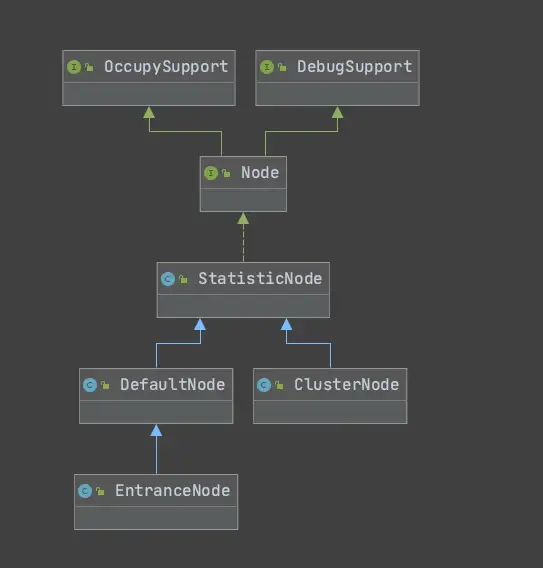
從Node的源碼注釋看,它會持有資源維度的實時統計數據,以下是接口里的方法定義,可以看到totalRequest、totalPass、totalSuccess、blockRequest、totalException、passQps等很多request、qps、thread的相關方法:
/**
* Holds real-time statistics for resources.
*
* @author qinan.qn
* @author leyou
* @author Eric Zhao
*/
public interface Node extends OccupySupport, DebugSupport {
long totalRequest();
long totalPass();
long totalSuccess();
long blockRequest();
long totalException();
double passQps();
double blockQps();
double totalQps();
double successQps();
……
}
2.3.2 StatisticNode
我們先從最基礎的StatisticNode開始看,源碼給出的定位是:
The statistic node keep three kinds of real-time statistics metrics:
metrics in second level ({@code rollingCounterInSecond})
metrics in minute level ({@code rollingCounterInMinute})
thread count
StatisticNode只有四個屬性,除了之前提到過的LongAddr類型的curThreadNum外,還有兩個屬性是Metric對象,通過入參已經屬性命名可以看出,一個用于秒級,一個用于分鐘級統計。接下來我們就要看看Metric
// StatisticNode持有兩個Metric,一個秒級一個分鐘級,由入參可知,秒級統計劃分了兩個時間窗口,窗口程度是500ms
private transient volatile Metric rollingCounterInSecond = new ArrayMetric(SampleCountProperty.SAMPLE_COUNT,
IntervalProperty.INTERVAL);
// 分鐘級統計劃分了60個時間窗口,窗口長度是1000ms
private transient Metric rollingCounterInMinute = new ArrayMetric(60, 60 * 1000, false);
/**
* The counter for thread count.
*/
private LongAdder curThreadNum = new LongAdder();
/**
* The last timestamp when metrics were fetched.
*/
private long lastFetchTime = -1;
ArrayMetric只有一個屬性LeapArray,其余都是用于統計的方法,LeapArray是sentinel中統計最基本的數據結構,這里有必要詳細看一下,總體就是根據timeMillis去獲取一個bucket,分為:沒有創建、有直接返回、被廢棄后的reset三種場景。
//以分鐘級的統計屬性為例,看一下時間窗口初始化過程
private transient Metric rollingCounterInMinute = new ArrayMetric(60, 60 * 1000, false);
public LeapArray(int sampleCount, int intervalInMs) {
AssertUtil.isTrue(sampleCount > 0, "bucket count is invalid: " + sampleCount);
AssertUtil.isTrue(intervalInMs > 0, "total time interval of the sliding window should be positive");
AssertUtil.isTrue(intervalInMs % sampleCount == 0, "time span needs to be evenly divided");
// windowLengthInMs = 60*1000 / 60 = 1000 滑動窗口時間長度,可見sentinel默認將單位時間分為了60個滑動窗口進行數據統計
this.windowLengthInMs = intervalInMs / sampleCount;
// 60*1000
this.intervalInMs = intervalInMs;
// 60
this.intervalInSecond = intervalInMs / 1000.0;
// 60
this.sampleCount = sampleCount;
// 數組長度60
this.array = new AtomicReferenceArray(sampleCount);
}
/**
* Get bucket item at provided timestamp.
*
* @param timeMillis a valid timestamp in milliseconds
* @return current bucket item at provided timestamp if the time is valid; null if time is invalid
*/
public WindowWrap currentWindow(long timeMillis) {
if (timeMillis < 0) {
return null;
}
// 根據當前時間戳算一個數組索引
int idx = calculateTimeIdx(timeMillis);
// Calculate current bucket start time.
// timeMillis % 1000
long windowStart = calculateWindowStart(timeMillis);
/*
* Get bucket item at given time from the array.
*
* (1) Bucket is absent, then just create a new bucket and CAS update to circular array.
* (2) Bucket is up-to-date, then just return the bucket.
* (3) Bucket is deprecated, then reset current bucket.
*/
while (true) {
WindowWrap old = array.get(idx);
if (old == null) {
/*
* B0 B1 B2 NULL B4
* ||_______|_______|_______|_______|_______||___
* 200 400 600 800 1000 1200 timestamp
* ^
* time=888
* bucket is empty, so create new and update
*
* If the old bucket is absent, then we create a new bucket at {@code windowStart},
* then try to update circular array via a CAS operation. Only one thread can
* succeed to update, while other threads yield its time slice.
*/
// newEmptyBucket 方法重寫,秒級和分鐘級統計對象實現不同
WindowWrap window = new WindowWrap(windowLengthInMs, windowStart, newEmptyBucket(timeMillis));
if (array.compareAndSet(idx, null, window)) {
// Successfully updated, return the created bucket.
return window;
} else {
// Contention failed, the thread will yield its time slice to wait for bucket available.
Thread.yield();
}
} else if (windowStart == old.windowStart()) {
/*
* B0 B1 B2 B3 B4
* ||_______|_______|_______|_______|_______||___
* 200 400 600 800 1000 1200 timestamp
* ^
* time=888
* startTime of Bucket 3: 800, so it's up-to-date
*
* If current {@code windowStart} is equal to the start timestamp of old bucket,
* that means the time is within the bucket, so directly return the bucket.
*/
return old;
} else if (windowStart > old.windowStart()) {
/*
* (old)
* B0 B1 B2 NULL B4
* |_______||_______|_______|_______|_______|_______||___
* ... 1200 1400 1600 1800 2000 2200 timestamp
* ^
* time=1676
* startTime of Bucket 2: 400, deprecated, should be reset
*
* If the start timestamp of old bucket is behind provided time, that means
* the bucket is deprecated. We have to reset the bucket to current {@code windowStart}.
* Note that the reset and clean-up operations are hard to be atomic,
* so we need a update lock to guarantee the correctness of bucket update.
*
* The update lock is conditional (tiny scope) and will take effect only when
* bucket is deprecated, so in most cases it won't lead to performance loss.
*/
if (updateLock.tryLock()) {
try {
// Successfully get the update lock, now we reset the bucket.
return resetWindowTo(old, windowStart);
} finally {
updateLock.unlock();
}
} else {
// Contention failed, the thread will yield its time slice to wait for bucket available.
Thread.yield();
}
} else if (windowStart < old.windowStart()) {
// Should not go through here, as the provided time is already behind.
return new WindowWrap(windowLengthInMs, windowStart, newEmptyBucket(timeMillis));
}
}
}
// 持有一個時間窗口對象的數據,會根據當前時間戳除以時間窗口長度然后散列到數組中
private int calculateTimeIdx(/*@Valid*/ long timeMillis) {
long timeId = timeMillis / windowLengthInMs;
// Calculate current index so we can map the timestamp to the leap array.
return (int)(timeId % array.length());
}
WindowWrap持有了windowLengthInMs, windowStart和LeapArray(分鐘統計實現是BucketLeapArray,秒級統計實現是OccupiableBucketLeapArray),對于分鐘級別的統計,MetricBucket維護了一個longAddr數組和一個配置的minRT
/**
* The fundamental data structure for metric statistics in a time span.
*
* @author jialiang.linjl
* @author Eric Zhao
* @see LeapArray
*/
public class BucketLeapArray extends LeapArray {
public BucketLeapArray(int sampleCount, int intervalInMs) {
super(sampleCount, intervalInMs);
}
@Override
public MetricBucket newEmptyBucket(long time) {
return new MetricBucket();
}
@Override
protected WindowWrap resetWindowTo(WindowWrap w, long startTime) {
// Update the start time and reset value.
w.resetTo(startTime);
w.value().reset();
return w;
}
}

對于秒級統計,QPS=20場景下,如何準確統計的問題,此處用到了另外一個LeapArry實現FutureBucketLeapArray,至于秒級統計如何保證沒有統計誤差,讀者可以再研究一下FutureBucketLeapArray的上下文就好。
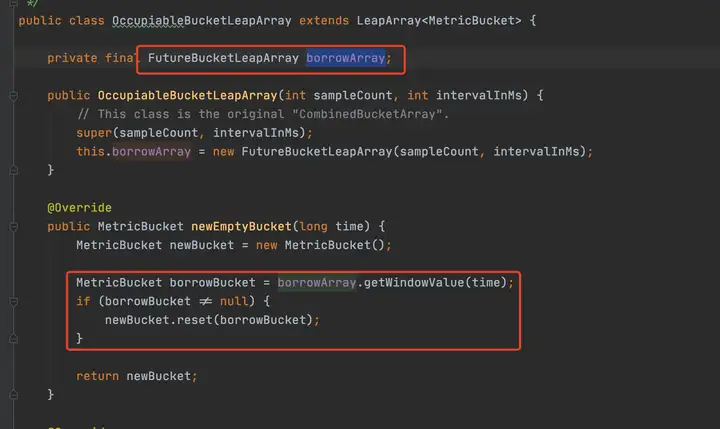
2.4 FlowSlot
2.4.1 常見限流算法
介紹sentinel限流實現前,先介紹一下常見限流算法,基本分為三種:計數器、漏斗、令牌桶。
計數器算法
顧名思義,計數器算法就是統計某個時間段內的請求,每單位時間加1,然后與配置的限流值(最大QPS)進行比較,如果超出則觸發限流。但是這種算法不能做到“平滑限流”,以1s為單位時間,100QPS為限流值為例,如下圖,會出現某時段超出限流值的情況
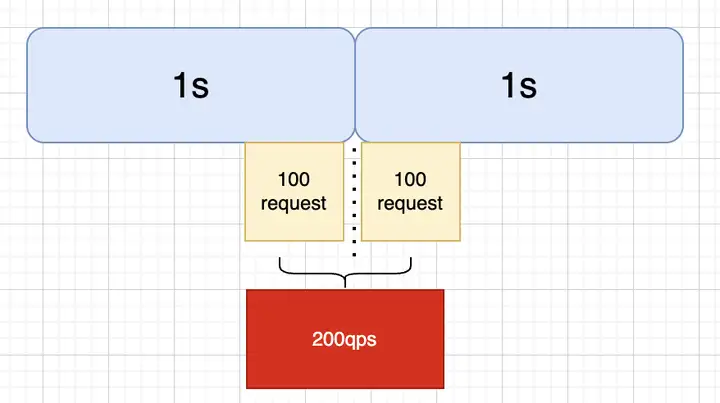
因此在單純計數器算法上,又出現了滑動窗口計數器算法,我們將統計時間細分,比如將1s統計時長分為5個時間窗口,通過滾動統計所有時間窗口的QPS作為系統實際的QPS的方式,就能解決上述臨界統計問題,后續我們看sentinel源碼時也能看到類似操作。
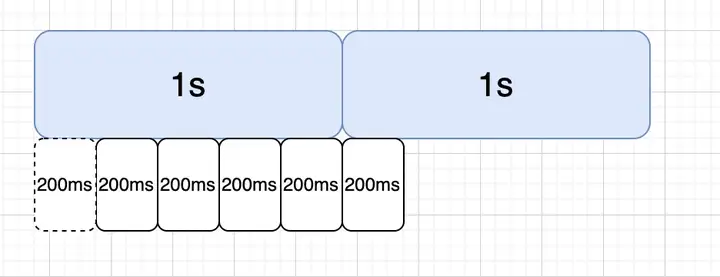
漏斗算法
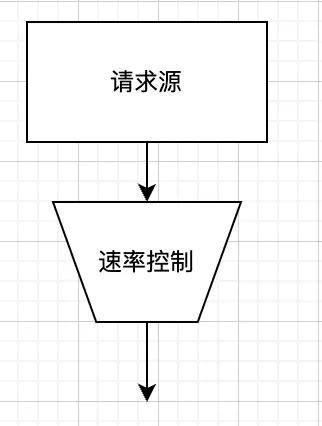
不論流量有多大都會先到漏桶中,然后以均勻的速度流出。如何在代碼中實現這個勻速呢?比如我們想讓勻速為100q/s,那么我們可以得到每流出一個流量需要消耗10ms,類似一個隊列,每隔10ms從隊列頭部取出流量進行放行,而我們的隊列也就是漏桶,當流量大于隊列的長度的時候,我們就可以拒絕超出的部分。
漏斗算法同樣的也有一定的缺點:無法應對突發流量。比如一瞬間來了100個請求,在漏桶算法中只能一個一個的過去,當最后一個請求流出的時候時間已經過了一秒了,所以漏斗算法比較適合請求到達比較均勻,需要嚴格控制請求速率的場景。
令牌桶算法
令牌桶算法和漏斗算法比較類似,區別是令牌桶存放的是令牌數量不是請求數量,令牌桶可以根據自身需求多樣性得管理令牌的生產和消耗,可以解決突發流量的問題。
2.4.2 單機限流模式
接下來我們看一下Sentinel中的限流實現,相比上述基本限流算法,Sentinel限流的第一個特性就是引入“資源”的概念,可以細粒度多樣性的支持特定資源、關聯資源、指定鏈路的限流。
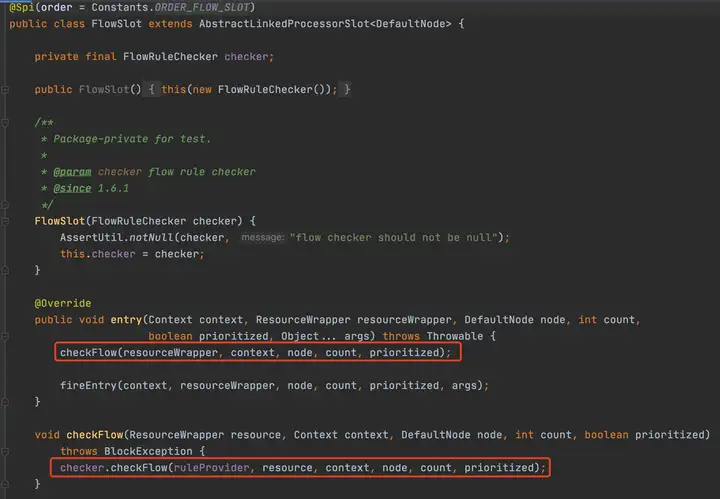
FlowSlot的主要邏輯都在FlowRuleChecker里,介紹之前,我們先看一下Sentinel關于規則的模型描述,下圖分別是限流、訪問控制規則、系統保護規則(Linux負載)、降級規則
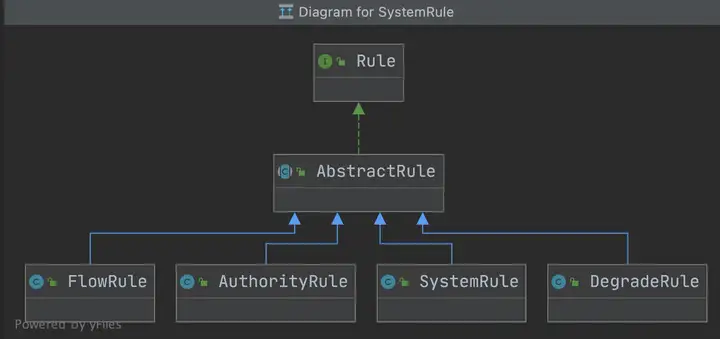
/**
* 流量控制兩種模式
* 0: thread count(當調用該api的線程數達到閾值的時候,進行限流)
* 1: QPS(當調用該api的QPS達到閾值的時候,進行限流)
*/
private int grade = RuleConstant.FLOW_GRADE_QPS;
/**
* 流量控制閾值,值含義與grade有關
*/
private double count;
/**
* 調用關系限流策略(可以支持關聯資源或指定鏈路的多樣性限流需求)
* 直接(api 達到限流條件時,直接限流)
* 關聯(當關聯的資源達到限流閾值時,就限流自己)
* 鏈路(只記錄指定鏈路上的流量)
* {@link RuleConstant#STRATEGY_DIRECT} for direct flow control (by origin);
* {@link RuleConstant#STRATEGY_RELATE} for relevant flow control (with relevant resource);
* {@link RuleConstant#STRATEGY_CHAIN} for chain flow control (by entrance resource).
*/
private int strategy = RuleConstant.STRATEGY_DIRECT;
/**
* Reference resource in flow control with relevant resource or context.
*/
private String refResource;
/**
* 流控效果:
* 0. default(reject directly),直接拒絕,拋異常FlowException
* 1. warm up, 慢啟動模式(根據coldFactor(冷加載因子,默認3)的值,從閾值/coldFactor,經過預熱時長,才達到設置的QPS閾值)
* 2. rate limiter 排隊等待
* 3. warm up + rate limiter
*/
private int controlBehavior = RuleConstant.CONTROL_BEHAVIOR_DEFAULT;
private int warmUpPeriodSec = 10;
/**
* Max queueing time in rate limiter behavior.
*/
private int maxQueueingTimeMs = 500;
/**
* 是否集群限流,默認為否
*/
private boolean clusterMode;
/**
* Flow rule config for cluster mode.
*/
private ClusterFlowConfig clusterConfig;
/**
* The traffic shaping (throttling) controller.
*/
private TrafficShapingController controller;
接著我們繼續分析FlowRuleChecker
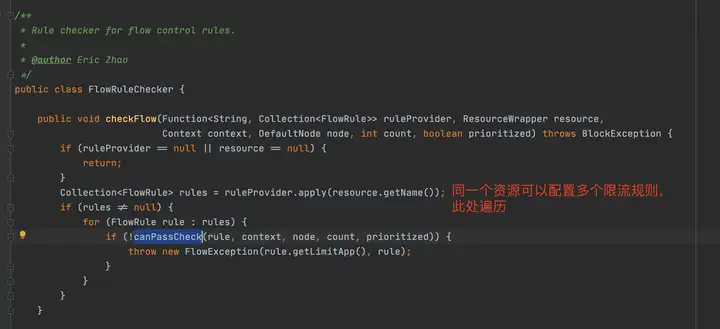

canPassCheck第一步會好看limitApp,這個是結合訪問授權限制規則使用的,默認是所有。

private static boolean passLocalCheck(FlowRule rule, Context context, DefaultNode node, int acquireCount, boolean prioritized) { // 根據策略選擇Node來進行統計(可以是本身Node、關聯的Node、指定的鏈路) Node selectedNode = selectNodeByRequesterAndStrategy(rule, context, node); if (selectedNode == null) { return true; } return rule.getRater().canPass(selectedNode, acquireCount, prioritized); } static Node selectNodeByRequesterAndStrategy(/*@NonNull*/ FlowRule rule, Context context, DefaultNode node) { // limitApp是訪問控制使用的,默認是default,不限制來源 String limitApp = rule.getLimitApp(); // 拿到限流策略 int strategy = rule.getStrategy(); String origin = context.getOrigin(); // 基于調用來源做鑒權 if (limitApp.equals(origin) && filterOrigin(origin)) { if (strategy == RuleConstant.STRATEGY_DIRECT) { // Matches limit origin, return origin statistic node. return context.getOriginNode(); } // return selectReferenceNode(rule, context, node); } else if (RuleConstant.LIMIT_APP_DEFAULT.equals(limitApp)) { if (strategy == RuleConstant.STRATEGY_DIRECT) { // Return the cluster node. return node.getClusterNode(); } return selectReferenceNode(rule, context, node); } else if (RuleConstant.LIMIT_APP_OTHER.equals(limitApp) && FlowRuleManager.isOtherOrigin(origin, rule.getResource())) { if (strategy == RuleConstant.STRATEGY_DIRECT) { return context.getOriginNode(); } return selectReferenceNode(rule, context, node); } return null; } static Node selectReferenceNode(FlowRule rule, Context context, DefaultNode node) { String refResource = rule.getRefResource(); int strategy = rule.getStrategy(); if (StringUtil.isEmpty(refResource)) { return null; } if (strategy == RuleConstant.STRATEGY_RELATE) { return ClusterBuilderSlot.getClusterNode(refResource); } if (strategy == RuleConstant.STRATEGY_CHAIN) { if (!refResource.equals(context.getName())) { return null; } return node; } // No node. return null; } // 此代碼是load限流規則時根據規則初始化流量整形控制器的邏輯,rule.getRater()返回TrafficShapingController private static TrafficShapingController generateRater(/*@Valid*/ FlowRule rule) { if (rule.getGrade() == RuleConstant.FLOW_GRADE_QPS) { switch (rule.getControlBehavior()) { // 預熱模式返回WarmUpController case RuleConstant.CONTROL_BEHAVIOR_WARM_UP: return new WarmUpController(rule.getCount(), rule.getWarmUpPeriodSec(), ColdFactorProperty.coldFactor); // 排隊模式返回ThrottlingController case RuleConstant.CONTROL_BEHAVIOR_RATE_LIMITER: return new ThrottlingController(rule.getMaxQueueingTimeMs(), rule.getCount()); // 預熱+排隊模式返回WarmUpRateLimiterController case RuleConstant.CONTROL_BEHAVIOR_WARM_UP_RATE_LIMITER: return new WarmUpRateLimiterController(rule.getCount(), rule.getWarmUpPeriodSec(), rule.getMaxQueueingTimeMs(), ColdFactorProperty.coldFactor); case RuleConstant.CONTROL_BEHAVIOR_DEFAULT: default: // Default mode or unknown mode: default traffic shaping controller (fast-reject). } } // 默認是DefaultController return new DefaultController(rule.getCount(), rule.getGrade()); }
Sentinel單機限流算法

上面我們看到根據限流規則controlBehavior屬性(流控效果),會初始化以下實現:
?DefaultController:是一個非常典型的滑動窗口計數器算法實現,將當前統計的qps和請求進來的qps進行求和,小于限流值則通過,大于則計算一個等待時間,稍后再試
?ThrottlingController:是漏斗算法的實現,實現思路已經在源碼片段中加了備注
?WarmUpController:實現參考了Guava的帶預熱的RateLimiter,區別是Guava側重于請求間隔,類似前面提到的令牌桶,而Sentinel更關注于請求數,和令牌桶算法有點類似
?WarmUpRateLimiterController:低水位使用預熱算法,高水位使用滑動窗口計數器算法排隊。
DefaultController
@Override
public boolean canPass(Node node, int acquireCount, boolean prioritized) {
int curCount = avgUsedTokens(node);
if (curCount + acquireCount > count) {
if (prioritized && grade == RuleConstant.FLOW_GRADE_QPS) {
long currentTime;
long waitInMs;
currentTime = TimeUtil.currentTimeMillis();
waitInMs = node.tryOccupyNext(currentTime, acquireCount, count);
if (waitInMs < OccupyTimeoutProperty.getOccupyTimeout()) {
node.addWaitingRequest(currentTime + waitInMs, acquireCount);
node.addOccupiedPass(acquireCount);
sleep(waitInMs);
// PriorityWaitException indicates that the request will pass after waiting for {@link @waitInMs}.
throw new PriorityWaitException(waitInMs);
}
}
return false;
}
return true;
}
ThrottlingController
public ThrottlingController(int queueingTimeoutMs, double maxCountPerStat) {
this(queueingTimeoutMs, maxCountPerStat, 1000);
}
public ThrottlingController(int queueingTimeoutMs, double maxCountPerStat, int statDurationMs) {
AssertUtil.assertTrue(statDurationMs > 0, "statDurationMs should be positive");
AssertUtil.assertTrue(maxCountPerStat >= 0, "maxCountPerStat should be >= 0");
AssertUtil.assertTrue(queueingTimeoutMs >= 0, "queueingTimeoutMs should be >= 0");
this.maxQueueingTimeMs = queueingTimeoutMs;
this.count = maxCountPerStat;
this.statDurationMs = statDurationMs;
// Use nanoSeconds when durationMs%count != 0 or count/durationMs> 1 (to be accurate)
// 可見配置限流值count大于1000時useNanoSeconds會是true否則是false
if (maxCountPerStat > 0) {
this.useNanoSeconds = statDurationMs % Math.round(maxCountPerStat) != 0 || maxCountPerStat / statDurationMs > 1;
} else {
this.useNanoSeconds = false;
}
}
@Override
public boolean canPass(Node node, int acquireCount) {
return canPass(node, acquireCount, false);
}
private boolean checkPassUsingNanoSeconds(int acquireCount, double maxCountPerStat) {
final long maxQueueingTimeNs = maxQueueingTimeMs * MS_TO_NS_OFFSET;
long currentTime = System.nanoTime();
// Calculate the interval between every two requests.
final long costTimeNs = Math.round(1.0d * MS_TO_NS_OFFSET * statDurationMs * acquireCount / maxCountPerStat);
// Expected pass time of this request.
long expectedTime = costTimeNs + latestPassedTime.get();
if (expectedTime <= currentTime) {
// Contention may exist here, but it's okay.
latestPassedTime.set(currentTime);
return true;
} else {
final long curNanos = System.nanoTime();
// Calculate the time to wait.
long waitTime = costTimeNs + latestPassedTime.get() - curNanos;
if (waitTime > maxQueueingTimeNs) {
return false;
}
long oldTime = latestPassedTime.addAndGet(costTimeNs);
waitTime = oldTime - curNanos;
if (waitTime > maxQueueingTimeNs) {
latestPassedTime.addAndGet(-costTimeNs);
return false;
}
// in race condition waitTime may <= 0
if (waitTime > 0) {
sleepNanos(waitTime);
}
return true;
}
}
// 漏斗算法具體實現
private boolean checkPassUsingCachedMs(int acquireCount, double maxCountPerStat) {
long currentTime = TimeUtil.currentTimeMillis();
// 計算兩次請求的間隔(分為秒級和納秒級)
long costTime = Math.round(1.0d * statDurationMs * acquireCount / maxCountPerStat);
// 請求的期望的時間
long expectedTime = costTime + latestPassedTime.get();
if (expectedTime <= currentTime) {
// latestPassedTime是AtomicLong類型,支持volatile語義
latestPassedTime.set(currentTime);
return true;
} else {
// 計算等待時間
long waitTime = costTime + latestPassedTime.get() - TimeUtil.currentTimeMillis();
// 如果大于最大排隊時間,則觸發限流
if (waitTime > maxQueueingTimeMs) {
return false;
}
long oldTime = latestPassedTime.addAndGet(costTime);
waitTime = oldTime - TimeUtil.currentTimeMillis();
if (waitTime > maxQueueingTimeMs) {
latestPassedTime.addAndGet(-costTime);
return false;
}
// in race condition waitTime may <= 0
if (waitTime > 0) {
sleepMs(waitTime);
}
return true;
}
}
@Override
public boolean canPass(Node node, int acquireCount, boolean prioritized) {
// Pass when acquire count is less or equal than 0.
if (acquireCount <= 0) {
return true;
}
// Reject when count is less or equal than 0.
// Otherwise, the costTime will be max of long and waitTime will overflow in some cases.
if (count <= 0) {
return false;
}
if (useNanoSeconds) {
return checkPassUsingNanoSeconds(acquireCount, this.count);
} else {
return checkPassUsingCachedMs(acquireCount, this.count);
}
}
private void sleepMs(long ms) {
try {
Thread.sleep(ms);
} catch (InterruptedException e) {
}
}
private void sleepNanos(long ns) {
LockSupport.parkNanos(ns);
}
long costTime = Math.round(1.0d * statDurationMs * acquireCount / maxCountPerStat);
由上述計算兩次請求間隔的公式我們可以發現,當maxCountPerStat(規則配置的限流值QPS)超過1000后,就無法準確計算出勻速排隊模式下的請求間隔時長,因此對應前面介紹的,當規則配置限流值超過1000QPS后,會采用checkPassUsingNanoSeconds,小于1000QPS會采用checkPassUsingCachedMs,對比一下checkPassUsingNanoSeconds和checkPassUsingCachedMs,可以發現主體思路沒變,只是統計維度從毫秒換算成了納秒,因此只看checkPassUsingCachedMs實現就可以
WarmUpController
@Override
public boolean canPass(Node node, int acquireCount, boolean prioritized) {
long passQps = (long) node.passQps();
long previousQps = (long) node.previousPassQps();
syncToken(previousQps);
// 開始計算它的斜率
// 如果進入了警戒線,開始調整他的qps
long restToken = storedTokens.get();
if (restToken >= warningToken) {
long aboveToken = restToken - warningToken;
// 消耗的速度要比warning快,但是要比慢
// current interval = restToken*slope+1/count
double warningQps = Math.nextUp(1.0 / (aboveToken * slope + 1.0 / count));
if (passQps + acquireCount <= warningQps) {
return true;
}
} else {
if (passQps + acquireCount <= count) {
return true;
}
}
return false;
}
protected void syncToken(long passQps) {
long currentTime = TimeUtil.currentTimeMillis();
currentTime = currentTime - currentTime % 1000;
long oldLastFillTime = lastFilledTime.get();
if (currentTime <= oldLastFillTime) {
return;
}
long oldValue = storedTokens.get();
long newValue = coolDownTokens(currentTime, passQps);
if (storedTokens.compareAndSet(oldValue, newValue)) {
long currentValue = storedTokens.addAndGet(0 - passQps);
if (currentValue < 0) {
storedTokens.set(0L);
}
lastFilledTime.set(currentTime);
}
}
private long coolDownTokens(long currentTime, long passQps) {
long oldValue = storedTokens.get();
long newValue = oldValue;
// 添加令牌的判斷前提條件:
// 當令牌的消耗程度遠遠低于警戒線的時候
if (oldValue < warningToken) {
newValue = (long)(oldValue + (currentTime - lastFilledTime.get()) * count / 1000);
} else if (oldValue > warningToken) {
if (passQps < (int)count / coldFactor) {
newValue = (long)(oldValue + (currentTime - lastFilledTime.get()) * count / 1000);
}
}
return Math.min(newValue, maxToken);
}
2.4.3 集群限流
passClusterCheck方法(因為clusterService找不到會降級到非集群限流)
private static boolean passClusterCheck(FlowRule rule, Context context, DefaultNode node, int acquireCount,
boolean prioritized) {
try {
// 獲取當前節點是Token Client還是Token Server
TokenService clusterService = pickClusterService();
if (clusterService == null) {
return fallbackToLocalOrPass(rule, context, node, acquireCount, prioritized);
}
long flowId = rule.getClusterConfig().getFlowId();
// 根據獲取的flowId通過TokenService進行申請token。從上面可知,它可能是TokenClient調用的,也可能是ToeknServer調用的。分別對應的類是DefaultClusterTokenClient和DefaultTokenService
TokenResult result = clusterService.requestToken(flowId, acquireCount, prioritized);
return applyTokenResult(result, rule, context, node, acquireCount, prioritized);
// If client is absent, then fallback to local mode.
} catch (Throwable ex) {
RecordLog.warn("[FlowRuleChecker] Request cluster token unexpected failed", ex);
}
// Fallback to local flow control when token client or server for this rule is not available.
// If fallback is not enabled, then directly pass.
return fallbackToLocalOrPass(rule, context, node, acquireCount, prioritized);
}
//獲取當前節點是Token Client還是Token Server。
//1) 如果當前節點的角色是Client,返回的TokenService為DefaultClusterTokenClient;
//2)如果當前節點的角色是Server,則默認返回的TokenService為DefaultTokenService。
private static TokenService pickClusterService() {
if (ClusterStateManager.isClient()) {
return TokenClientProvider.getClient();
}
if (ClusterStateManager.isServer()) {
return EmbeddedClusterTokenServerProvider.getServer();
}
return null;
}
集群限流模式
Sentinel 集群限流服務端有兩種啟動方式:
?嵌入模式(Embedded)適合應用級別的限流,部署簡單,但對應用性能有影響
?獨立模式(Alone)適合全局限流,需要獨立部署
考慮到文章篇幅,集群限流有機會再展開詳細介紹。
集群限流模式降級
private static boolean passClusterCheck(FlowRule rule, Context context, DefaultNode node, int acquireCount,
boolean prioritized) {
try {
TokenService clusterService = pickClusterService();
if (clusterService == null) {
return fallbackToLocalOrPass(rule, context, node, acquireCount, prioritized);
}
long flowId = rule.getClusterConfig().getFlowId();
TokenResult result = clusterService.requestToken(flowId, acquireCount, prioritized);
return applyTokenResult(result, rule, context, node, acquireCount, prioritized);
// If client is absent, then fallback to local mode.
} catch (Throwable ex) {
RecordLog.warn("[FlowRuleChecker] Request cluster token unexpected failed", ex);
}
// Fallback to local flow control when token client or server for this rule is not available.
// If fallback is not enabled, then directly pass.
// 可以看到如果集群限流有異常,會降級到單機限流模式,如果配置不允許降級,那么直接會跳過此次校驗
return fallbackToLocalOrPass(rule, context, node, acquireCount, prioritized);
}
2.5 DegradeSlot
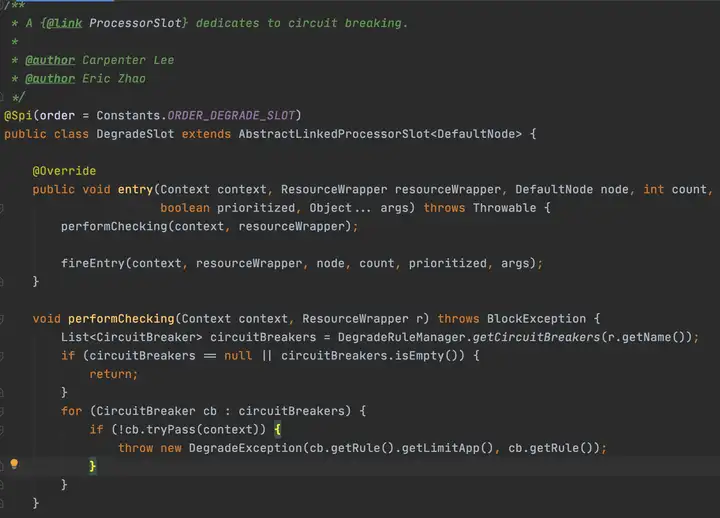
CircuitBreaker
大神對斷路器的解釋:https://martinfowler.com/bliki/CircuitBreaker.html
首先就看到了根據資源名稱獲取斷路器列表,Sentinel的斷路器有兩個實現:RT模式使用ResponseTimeCircuitBreaker、異常模式使用ExceptionCircuitBreaker
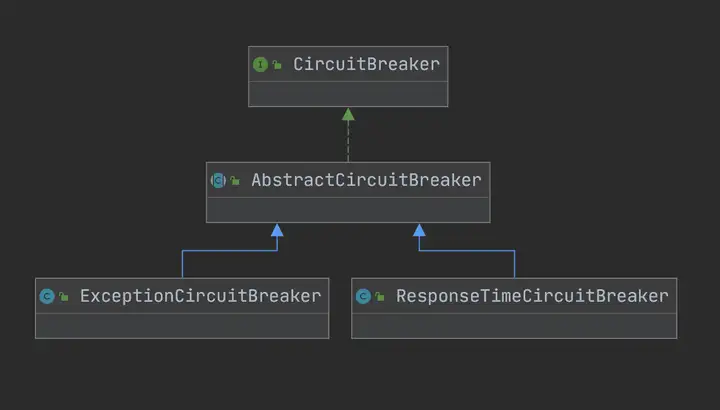
public interface CircuitBreaker {
/**
* Get the associated circuit breaking rule.
*
* @return associated circuit breaking rule
*/
DegradeRule getRule();
/**
* Acquires permission of an invocation only if it is available at the time of invoking.
*
* @param context context of current invocation
* @return {@code true} if permission was acquired and {@code false} otherwise
*/
boolean tryPass(Context context);
/**
* Get current state of the circuit breaker.
*
* @return current state of the circuit breaker
*/
State currentState();
/**
* Record a completed request with the context and handle state transformation of the circuit breaker.
* Called when a passed invocation finished.
*
* @param context context of current invocation
*/
void onRequestComplete(Context context);
/**
* Circuit breaker state.
*/
enum State {
/**
* In {@code OPEN} state, all requests will be rejected until the next recovery time point.
*/
OPEN,
/**
* In {@code HALF_OPEN} state, the circuit breaker will allow a "probe" invocation.
* If the invocation is abnormal according to the strategy (e.g. it's slow), the circuit breaker
* will re-transform to the {@code OPEN} state and wait for the next recovery time point;
* otherwise the resource will be regarded as "recovered" and the circuit breaker
* will cease cutting off requests and transform to {@code CLOSED} state.
*/
HALF_OPEN,
/**
* In {@code CLOSED} state, all requests are permitted. When current metric value exceeds the threshold,
* the circuit breaker will transform to {@code OPEN} state.
*/
CLOSED
}
}
以ExceptionCircuitBreaker為例看一下具體實現
public class ExceptionCircuitBreaker extends AbstractCircuitBreaker {
// 異常模式有兩種,異常率和異常數
private final int strategy;
// 最小請求數
private final int minRequestAmount;
// 閾值
private final double threshold;
// LeapArray是sentinel統計數據非常重要的一個結構,主要封裝了時間窗口相關的操作
private final LeapArray stat;
public ExceptionCircuitBreaker(DegradeRule rule) {
this(rule, new SimpleErrorCounterLeapArray(1, rule.getStatIntervalMs()));
}
ExceptionCircuitBreaker(DegradeRule rule, LeapArray stat) {
super(rule);
this.strategy = rule.getGrade();
boolean modeOk = strategy == DEGRADE_GRADE_EXCEPTION_RATIO || strategy == DEGRADE_GRADE_EXCEPTION_COUNT;
AssertUtil.isTrue(modeOk, "rule strategy should be error-ratio or error-count");
AssertUtil.notNull(stat, "stat cannot be null");
this.minRequestAmount = rule.getMinRequestAmount();
this.threshold = rule.getCount();
this.stat = stat;
}
@Override
protected void resetStat() {
// Reset current bucket (bucket count = 1).
stat.currentWindow().value().reset();
}
@Override
public void onRequestComplete(Context context) {
Entry entry = context.getCurEntry();
if (entry == null) {
return;
}
Throwable error = entry.getError();
SimpleErrorCounter counter = stat.currentWindow().value();
if (error != null) {
counter.getErrorCount().add(1);
}
counter.getTotalCount().add(1);
handleStateChangeWhenThresholdExceeded(error);
}
private void handleStateChangeWhenThresholdExceeded(Throwable error) {
if (currentState.get() == State.OPEN) {
return;
}
if (currentState.get() == State.HALF_OPEN) {
// In detecting request
if (error == null) {
fromHalfOpenToClose();
} else {
fromHalfOpenToOpen(1.0d);
}
return;
}
List counters = stat.values();
long errCount = 0;
long totalCount = 0;
for (SimpleErrorCounter counter : counters) {
+= counter.errorCount.sum();
totalCount += counter.totalCount.sum();
}
if (totalCount < minRequestAmount) {
return;
}
double curCount = errCount;
if (strategy == DEGRADE_GRADE_EXCEPTION_RATIO) {
// Use errorRatio
curCount = errCount * 1.0d / totalCount;
}
if (curCount > threshold) {
transformToOpen(curCount);
}
}
static class SimpleErrorCounter {
private LongAdder errorCount;
private LongAdder totalCount;
public SimpleErrorCounter() {
this.errorCount = new LongAdder();
this.totalCount = new LongAdder();
}
public LongAdder getErrorCount() {
return errorCount;
}
public LongAdder getTotalCount() {
return totalCount;
}
public SimpleErrorCounter reset() {
errorCount.reset();
totalCount.reset();
return this;
}
@Override
public String toString() {
return "SimpleErrorCounter{" +
"errorCount=" + errorCount +
", totalCount=" + totalCount +
'}';
}
}
static class SimpleErrorCounterLeapArray extends LeapArray {
public SimpleErrorCounterLeapArray(int sampleCount, int intervalInMs) {
super(sampleCount, intervalInMs);
}
@Override
public SimpleErrorCounter newEmptyBucket(long timeMillis) {
return new SimpleErrorCounter();
}
@Override
protected WindowWrap resetWindowTo(WindowWrap w, long startTime) {
// Update the start time and reset value.
w.resetTo(startTime);
w.value().reset();
return w;
}
}
}
2.6 SystemSlot
校驗邏輯主要集中在com.alibaba.csp.sentinel.slots.system.SystemRuleManager#checkSystem,以下是片段,可以看到,作為負載保護規則校驗,實現了集群的QPS、線程、RT(響應時間)、系統負載的控制,除系統負載以外,其余統計都是依賴StatisticSlot實現,系統負載是通過SystemRuleManager定時調度SystemStatusListener,通過OperatingSystemMXBean去獲取
/**
* Apply {@link SystemRule} to the resource. Only inbound traffic will be checked.
*
* @param resourceWrapper the resource.
* @throws BlockException when any system rule's threshold is exceeded.
*/
public static void checkSystem(ResourceWrapper resourceWrapper, int count) throws BlockException {
if (resourceWrapper == null) {
return;
}
// Ensure the checking switch is on.
if (!checkSystemStatus.get()) {
return;
}
// for inbound traffic only
if (resourceWrapper.getEntryType() != EntryType.IN) {
return;
}
// total qps 此處是拿到某個資源在集群中的QPS總和,相關概念可以會看初始化關于Node的介紹
double currentQps = Constants.ENTRY_NODE.passQps();
if (currentQps + count > qps) {
throw new SystemBlockException(resourceWrapper.getName(), "qps");
}
// total thread
int currentThread = Constants.ENTRY_NODE.curThreadNum();
if (currentThread > maxThread) {
throw new SystemBlockException(resourceWrapper.getName(), "thread");
}
double rt = Constants.ENTRY_NODE.avgRt();
if (rt > maxRt) {
throw new SystemBlockException(resourceWrapper.getName(), "rt");
}
// load. BBR algorithm.
if (highestSystemLoadIsSet && getCurrentSystemAvgLoad() > highestSystemLoad) {
if (!checkBbr(currentThread)) {
throw new SystemBlockException(resourceWrapper.getName(), "load");
}
}
// cpu usage
if (highestCpuUsageIsSet && getCurrentCpuUsage() > highestCpuUsage) {
throw new SystemBlockException(resourceWrapper.getName(), "cpu");
}
}
private static boolean checkBbr(int currentThread) {
if (currentThread > 1 &&
currentThread > Constants.ENTRY_NODE.maxSuccessQps() * Constants.ENTRY_NODE.minRt() / 1000) {
return false;
}
return true;
}
public static double getCurrentSystemAvgLoad() {
return statusListener.getSystemAverageLoad();
}
public static double getCurrentCpuUsage() {
return statusListener.getCpuUsage();
}
public class SystemStatusListener implements Runnable {
volatile double currentLoad = -1;
volatile double currentCpuUsage = -1;
volatile String reason = StringUtil.EMPTY;
volatile long processCpuTime = 0;
volatile long processUpTime = 0;
public double getSystemAverageLoad() {
return currentLoad;
}
public double getCpuUsage() {
return currentCpuUsage;
}
@Override
public void run() {
try {
OperatingSystemMXBean osBean = ManagementFactory.getPlatformMXBean(OperatingSystemMXBean.class);
currentLoad = osBean.getSystemLoadAverage();
/*
* Java Doc copied from {@link OperatingSystemMXBean#getSystemCpuLoad()}:
* Returns the "recent cpu usage" for the whole system. This value is a double in the [0.0,1.0] interval.
* A value of 0.0 means that all CPUs were idle during the recent period of time observed, while a value
* of 1.0 means that all CPUs were actively running 100% of the time during the recent period being
* observed. All values between 0.0 and 1.0 are possible depending of the activities going on in the
* system. If the system recent cpu usage is not available, the method returns a negative value.
*/
double systemCpuUsage = osBean.getSystemCpuLoad();
// calculate process cpu usage to support application running in container environment
RuntimeMXBean runtimeBean = ManagementFactory.getPlatformMXBean(RuntimeMXBean.class);
long newProcessCpuTime = osBean.getProcessCpuTime();
long newProcessUpTime = runtimeBean.getUptime();
int cpuCores = osBean.getAvailableProcessors();
long processCpuTimeDiffInMs = TimeUnit.NANOSECONDS
.toMillis(newProcessCpuTime - processCpuTime);
long processUpTimeDiffInMs = newProcessUpTime - processUpTime;
double processCpuUsage = (double) processCpuTimeDiffInMs / processUpTimeDiffInMs / cpuCores;
processCpuTime = newProcessCpuTime;
processUpTime = newProcessUpTime;
currentCpuUsage = Math.max(processCpuUsage, systemCpuUsage);
if (currentLoad > SystemRuleManager.getSystemLoadThreshold()) {
writeSystemStatusLog();
}
} catch (Throwable e) {
RecordLog.warn("[SystemStatusListener] Failed to get system metrics from JMX", e);
}
}
private void writeSystemStatusLog() {
StringBuilder sb = new StringBuilder();
sb.append("Load exceeds the threshold: ");
sb.append("load:").append(String.format("%.4f", currentLoad)).append("; ");
sb.append("cpuUsage:").append(String.format("%.4f", currentCpuUsage)).append("; ");
sb.append("qps:").append(String.format("%.4f", Constants.ENTRY_NODE.passQps())).append("; ");
sb.append("rt:").append(String.format("%.4f", Constants.ENTRY_NODE.avgRt())).append("; ");
sb.append("thread:").append(Constants.ENTRY_NODE.curThreadNum()).append("; ");
sb.append("success:").append(String.format("%.4f", Constants.ENTRY_NODE.successQps())).append("; ");
sb.append("minRt:").append(String.format("%.2f", Constants.ENTRY_NODE.minRt())).append("; ");
sb.append("maxSuccess:").append(String.format("%.2f", Constants.ENTRY_NODE.maxSuccessQps())).append("; ");
RecordLog.info(sb.toString());
}
}
三、京東版最佳實踐
3.1 使用方式
Sentinel使用方式本身非常簡單,就是一個注解,但是要考慮規則加載和規則持久化的方式,現有的方式有:
?使用Sentinel-dashboard功能:使用面板接入需要維護一個配置規則的管理端,考慮到偏后端的系統需要額外維護一個面板成本較大,如果是像RPC框架這種本身有管理端的接入可以考慮次方案。
?中間件(如:zookepper、nacos、eureka、redis等):Sentinel源碼extension包里提供了類似的實現,如下圖
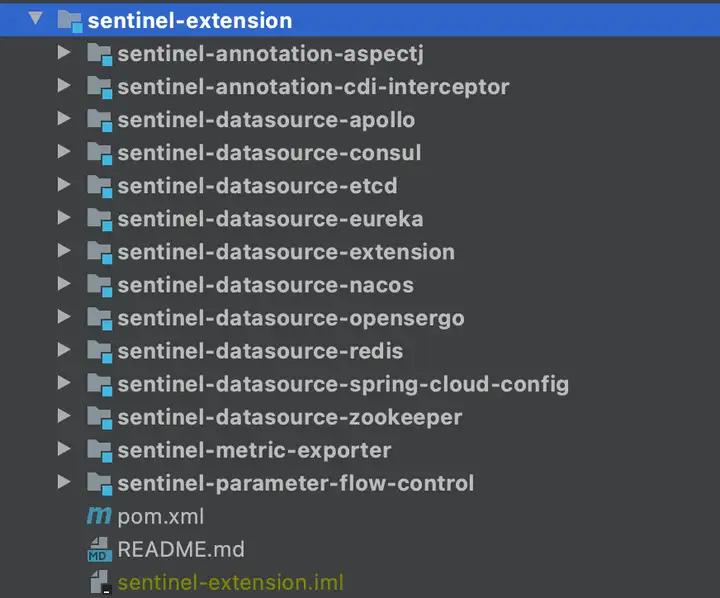
結合京東實際,我實現了一個規則熱部署的Sentinel組件,實現方式類似zookeeper的方式,將規則記錄到ducc的一個key上,在spring容器啟動時做第一次規則加載和監聽器注冊,組件也做一了一些規則讀取,校驗、實例化不同規則對象的工作
插件使用方式:注解+配置
第一步 引入組件
com.jd.ldop.tools
sentinel-tools
1.0.0-SNAPSHOT
第二步 初始化sentinelProcess
支持ducc、本地文件讀取、直接寫入三種方式規則寫入方式
目前支持限流規則、熔斷降級規則兩種模式,系統負載保護模式待開發和驗證
ducc上配置如下:
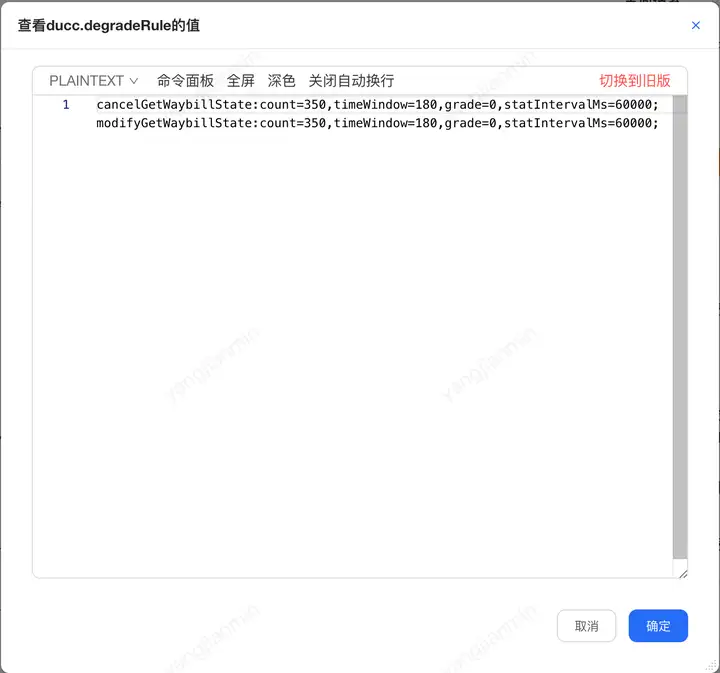
第三步 定義資源和關聯類型
通過@SentinelResource可以直接在任意位置定義資源名以及對應的熔斷降級或者限流方式、回調方法等,同時也可以指定關聯類型,支持直接、關聯、指定鏈路三種
@Override
@SentinelResource(value = "modifyGetWaybillState", fallback = "executeDegrade")
public ExecutionResult> execute(@NotNull Model imodel) {
// 業務邏輯處理
}
public ExecutionResult> executeDegrade(@NotNull Model imodel) {
// 降級業務邏輯處理
}
3.2 應用場景
組件支持任意的業務降級、限流、負載保護
四、Sentinel壓測數據
4.1 壓測目標
調用量:1.2W/m
應用機器內存穩定在50%以內
機器規格: 8C16G50G磁盤*2
Sentinel降級規則:
count=350-------慢調用臨界閾值350ms
timeWindow=180------熔斷時間窗口180s
grade=0-----降級模式 慢調用
statIntervalMs=60000------統計時長1min
4.2 壓測結果
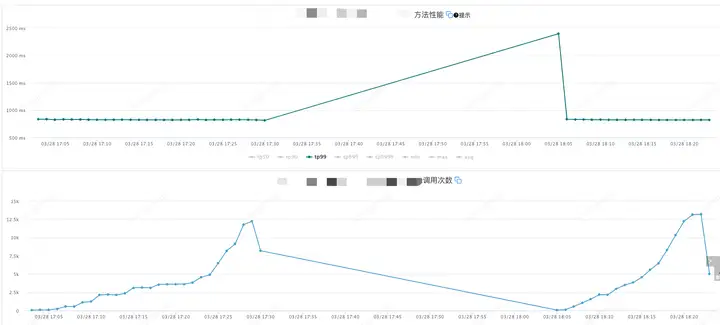
應用機器監控:
壓測分為了兩個階段,分別是組件開啟和組件關閉兩次,前半部分是組件開啟的情況,后半部分是組件關閉的情況



應用進程內存分析,和sentinel有關的前三對象是
com.alibaba.csp.sentinel.node.metric.MetricNode





com.alibaba.csp.sentinel.CtEntry


com.alibaba.csp.sentinel.context.Context



4.3 壓測結論
使Sentinel組件實現系統服務自動降級或限流,由于sentinel會按照滑動窗口周期性統計數據,因此會占用一定的機器內存,使用時應設置合理的規則,如:合理的統計時長、避免過多的Sentinel資源創建等。
總體來說,使用sentinel組件對應用cpu和內存影響不大。
審核編輯 黃宇
-
負載
+關注
關注
2文章
560瀏覽量
34253 -
Sentinel
+關注
關注
0文章
10瀏覽量
7143
發布評論請先 登錄
相關推薦
開源分析和落地方案—Sentinel篇
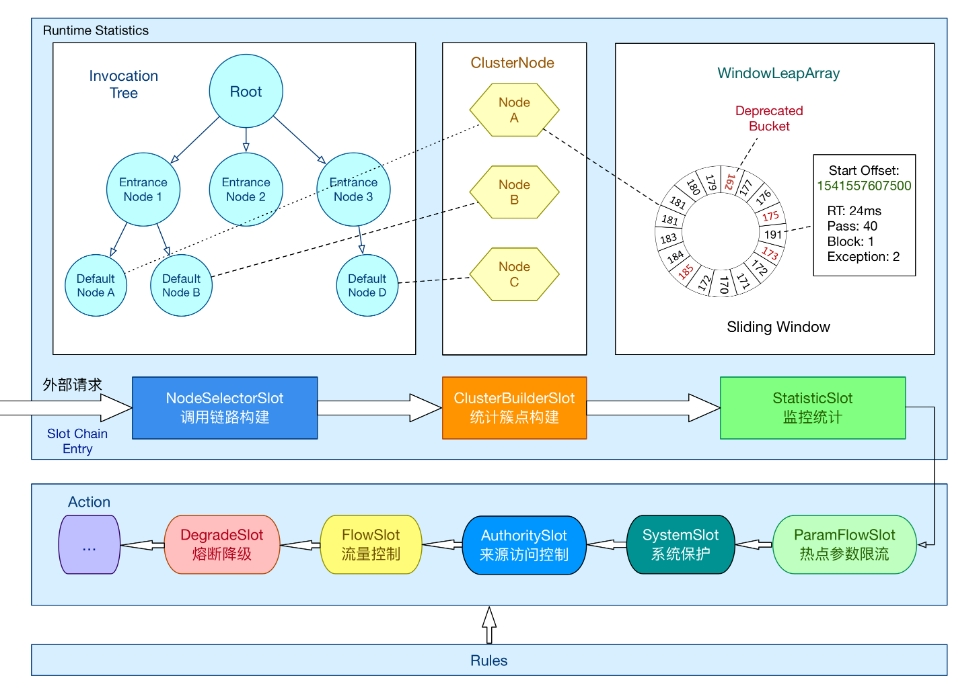
最佳天線實踐、布局指南以及天線調試程序
USB限流IC,限流開關保護芯片
USB限流IC,限流開關保護芯片
如何根據負載輕松而精確地進行限流?
根據負載添加限流功能的兩種方式
阿里巴巴宣布 Sentinel 開源,進一步完善 Dubbo 生態
Sentinel如何通過限流實現服務的高可用性
Sentinel 如何通過勻速請求和冷啟動來保障服務的穩定性
限流和降級(下) | 如何打造平臺穩定性能力(二)
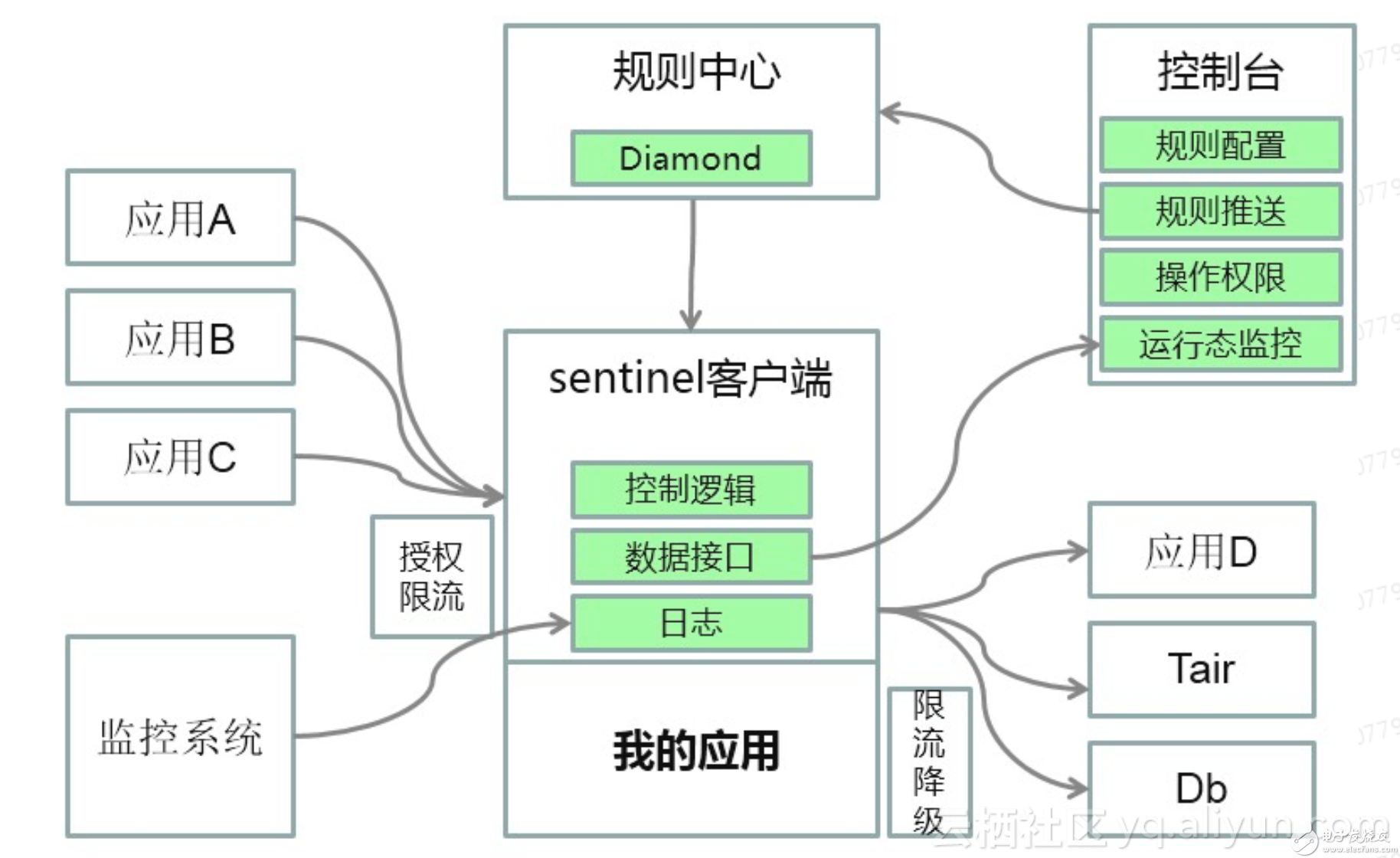




 基于Sentinel自研組件的系統限流、降級、負載保護最佳實踐探索
基于Sentinel自研組件的系統限流、降級、負載保護最佳實踐探索











評論